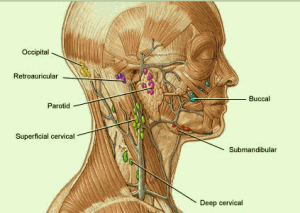The occipital lymph nodes or glands, usually numbering one to three, are components of the lymphatic system. The system acts as the secondary unit of the body’s immune system. These systems, in combination, fight the various disease causing pathogens like viruses and bacteria. All the organs of the body, with the exception of the central nervous system fall under the lymphatic system’s protection.
The lymphatic system is composed of lymphatic ducts, capillaries, nodes and body organs like the tonsils, spleen, etc. The lymph nodes look like beans and are most noticeable in the neck, armpits, the back of the ears, the groin region, the back of the head, under the chin and jaw. Lymph nodes defend the body against infections with the aid lymphocytes, a kind of white blood cells.
Lymph is a clear fluid that oozes out of the cells and blood vessels and is accumulated in the spaces between the cells of the body. It is collected by the lymph ducts, capillaries and vessels and passed onto the lymph nodes, where the lymphocytes fight against the pathogens occurring in it. The lymph then goes down the lymphatic system and finally becomes a part of the blood circulatory system.
Occipital Lymph Node location
The occipital lymph nodes are responsible for the transportation of lymph from region behind the head. They are situated next to the muscles between the neck and the head, adjacent to the occipital bone of the skull. They can be said to be situated next to the trapezius, as well as near the insertion point of the semispinalis capitis muscle. They are oval-shaped or ball like organs, measuring from a few millimeters to 1-2 centimeters in size.
The afferent lymph vessels leading to the occipital lymph nodes gets the lymph from the occipital area of the scalp, while the efferent vessels leading away from them drain the lymph into the superior deep cervical lymph nodes. In the fight against pathogens, there may be possible risk of occipital lymph node infections. In these cases, they may experience enlargement indicating the occurrence of abnormalities of the occipital lymph nodes.
Occipital lymph node swelling
A condition of swollen occipital lymph nodes is referred to as lymphadenopathy. When the body is invaded by microorganisms, the immune system rushes to defend the body. Likewise, the occurrence of microbes in the lymph nodes causes the lymphocytes to fight them. The passing of information about such actions via neurotransmitters or hormones to the immune system, results in the transportation of more fighter cells to such infected nodes.
Such increase in the count of body cells at the area of action, results in enlargement of sub-occipital or occipital lymph nodes. It also leads to inflammation of the nodes. One of the common symptoms of the condition is irritation marked by itchy scalp. The swelling of the occipital lymph nodes also compresses the nerves in the nearby regions. Stiffness and neck pain is also observed. Besides the deposition of debris, other reasons that lead to occipital lymph node enlargement include occurrence of multiplication of body cells such as microphages or monocytes.
Causes of occipital lymph node swelling
Swelling of occipital lymph node rarely develops due to cancers. In most cases, the cause of the condition may be an infected puncture or cut, bug bite, lice, ringworm, dandruff or an episode of infection by viruses, bacteria or fungus.
In such cases, it is important to keep a watch over the size of the occipital lymph nodes. Even an inch in size increase is considered abnormal. The cases involving constant swelling of the occipital lymph nodes, or wherein the condition has persisted for more than a month along with nighttime sweating and fever, have to be checked by a doctor.
Lymphoma and the occipital lymph node
The T cells and B cells are two kinds of lymphatic cells. The cells work in combination to protect the body against attack by germs. The B cells make proteins which get attached to pathogens and anomalistic cells occurring in the lymph. The T cells identify these marker proteins and destroy such tagged items.
Lymphoma refers to cancer of the lymphatic cells. It develops when either the T cells or B cells undergo unregulated divisions. Such cells attack the occipital lymph node and/or other nodes as well as organs of the body that are constituents of the lymphatic system, and group together to create a tumor. These malignant cells rare metastasize from the occipital lymph nodes to other parts of the body. However, they can easily spread from one occipital lymph node to the other two.
Leukemia is a form of cancer that can affect the bone marrow, spleen and/or other organs of the lymphatic system.
Treatment of occipital lymph node anomalies
- Infections of the occipital lymph node are treated as per the kind of infection with antifungal creams, antibiotics, etc.
- Infections by resistant strains of bacteria may require further tests and use of stronger antibiotics
- Ringworm and lice are treated with different drugs
- Cancers affecting occipital lymph nodes are treated as per the underlying causes and may involve chemotherapy, surgery, radiation therapy, targeted therapy, etc.
Occipital Lymph Node Picture

Hi, Neat post. There’s a problem with your site in internet explorer, would test this?IE still is the market leader and a large portion of people will miss your great writing due to this problem.